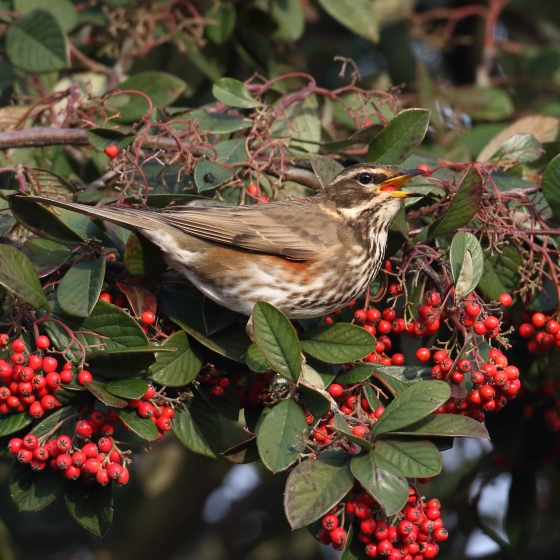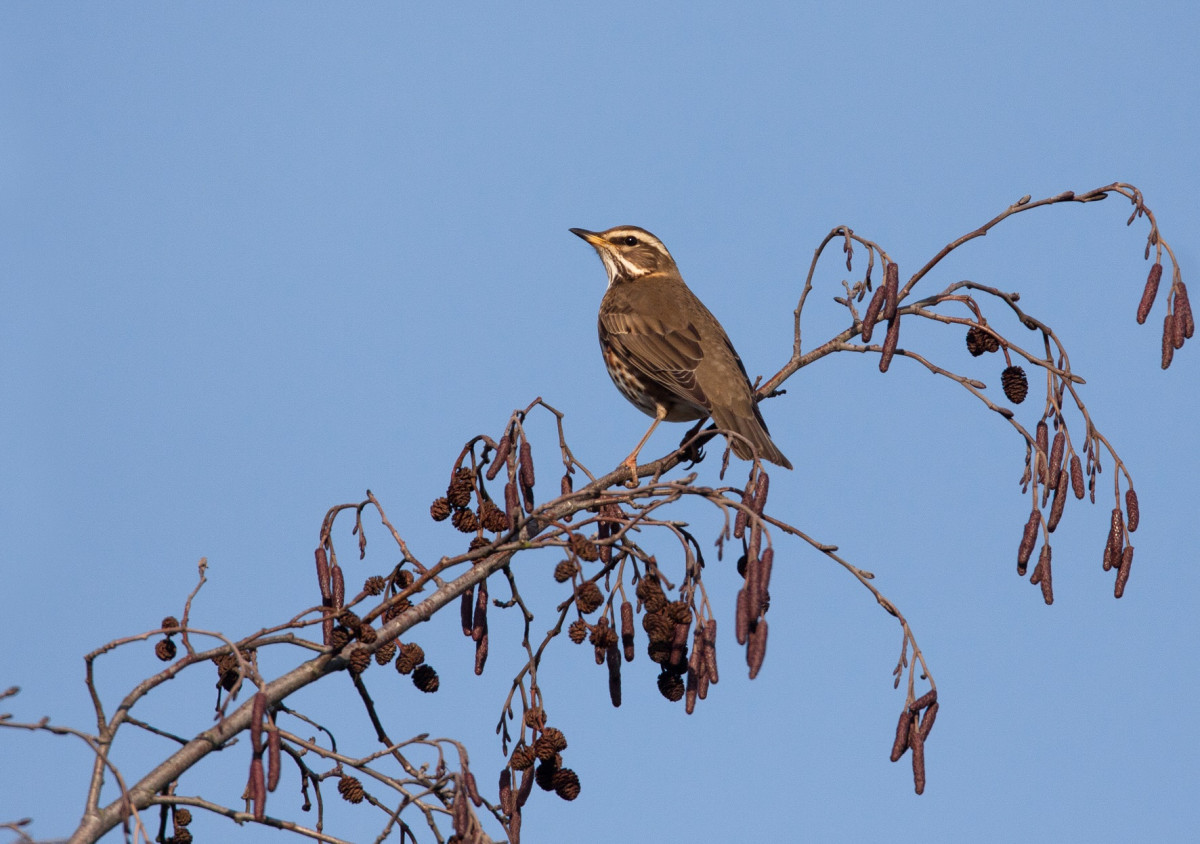Redwing

Introduction
One of the 'winter thrushes', the Song Thrush-like Redwings begin arriving in Britain & Ireland during the latter half of September, before leaving again by mid April.
It is estimated that around 700,000 Redwings winter in the UK, although numbers can fluctuate sharply between years. Redwings come in search of berries, and, when crops fail in northern and eastern Europe, large numbers cross the North Sea. A small number of Redwings also breed in the UK, but only in the far north of Scotland.
During the early winter the Redwing is very much a bird of open country but during freezing conditions Redwings can often be seen in parks and gardens. With birds arriving from both Iceland and Fennoscandia, Redwings can be found across Britain & Ireland during the winter months.

Key Stats
Identification
ID Videos
This section features BTO training videos headlining this species, or featuring it as a potential confusion species.
Redwing and Fieldfare
#BirdSongBasics: Redwing and Fieldfare
GBW: Redwing and Fieldfare
Songs and Calls
Song:
Call:
Flight call:
Status and Trends
Conservation Status
Population Change
Most Redwing seen in the UK are present for the winter only and return to Scandinavia and Iceland to breed. However, small numbers of Redwing do breed in the UK, with the vast majority of breeding records occurring in Scotland. The breeding population has been stable over the 25 years to 2019,with a mean of 27 pairs/singing males reported to the RBBP over the five-year period 2015–2019 (Eaton et al. 2021). However, there has been a range contraction of 32% in the number of occupied 10-km squares between 1968–72 and 2008–11 (Balmer et al. 2013).
Distribution
Redwings are common autumn migrants and winter visitors, found in 92% of 10-km squares during winter. The higher Scottish uplands are among the few areas with no Redwings in winter although many occupied upland areas support very low densities in winter. Highest densities occur in western lowlands, in particular throughout Ireland and in southwest Wales, southwest England and the West Midlands. Redwings are very rare breeders, with probable and confirmed breeding records restricted to northern Scotland, in particular Inverness-shire, Ross-shire, Sutherland and Shetland. The picture is clouded by many late departing winter visitors, many of which sing prioer to departure.
Occupied 10-km squares in UK
or view it on Bird Atlas Mapstore.
or view it on Bird Atlas Mapstore.
European Distribution Map
Distribution Change
Change in occupied 10-km squares in the UK
or view it on Bird Atlas Mapstore.
or view it on Bird Atlas Mapstore.
Seasonality
Redwing is largely a winter visitor, arriving from Icelandic and continental breeding grounds in October and remaining into late winter and early spring. The tiny breeding population is rarely encountered on complete lists and does not appear here.
Weekly pattern of occurrence
The graph shows when the species is present in the UK, with taller bars indicating a higher likelihood of encountering the species in appropriate regions and habitats.

Migrant arrival timing
Movement
Britain & Ireland movement
Foreign locations of birds ringed or recovered in Britain & Ireland
Dots show the foreign destinations of birds ringed in Britain & Ireland, and the origins of birds ringed overseas that were subsequently recaptured, resighted or found dead in Britain & Ireland. Dot colours indicate the time of year that the species was present at the location.
- Winter (Nov-Feb)
- Spring (Mar-Apr)
- Summer (May-Jul)
- Autumn (Aug-Oct)

European movements
EuroBirdPortal uses birdwatcher's records, such as those logged in BirdTrack to map the flows of birds as they arrive and depart Europe. See maps for this species here.
The Eurasian-African Migration Atlas shows movements of individual birds ringed or recovered in Europe. See maps for this species here.
Biology
Productivity and Nesting
Nesting timing
Egg measurements
Clutch Size
Survival and Longevity
Survival is shown as the proportion of birds surviving from one year to the next and is derived from bird ringing data. It can also be used to estimate how long birds typically live.
View number ringed each year in the Online Ringing Report.
lifespan
Survival of adults
Biometrics
Wing length and body weights are from live birds (source).
Wing length
Body weight
Ring Size
Classification, names and codes
Classification and Codes
- Order: Passeriformes
- Family: Turdidae
- Scientific name: Turdus iliacus
- Authority: Linnaeus, 1766
- BTO 2-letter code: RE
- BTO 5-letter code: REDWI
- Euring code number: 12010
Alternate species names
- Catalan: tord ala-roig
- Czech: drozd cvrcala
- Danish: Vindrossel
- Dutch: Koperwiek
- Estonian: vainurästas
- Finnish: punakylkirastas
- French: Grive mauvis
- Gaelic: Smeòrach-an-t-sneachda
- German: Rotdrossel
- Hungarian: szolorigó
- Icelandic: Skógarþröstur
- Irish: Deargán Sneachta
- Italian: Tordo sassello
- Latvian: plukškis
- Lithuanian: baltabruvis strazdas
- Norwegian: Rødvingetrost
- Polish: drozdzik
- Portuguese: sabiá-ruivo
- Slovak: drozd cervenkavý
- Slovenian: vinski drozg
- Spanish: Zorzal alirrojo
- Swedish: rödvingetrast
- Welsh: Coch Dan Adain
- English folkname(s): Swinepipe, Wind Thrush
Research
Causes of Change and Solutions
Causes of change
The drivers of change in the numbers of breeding Redwing in the UK are not known.
Publications (2)
Birds of Conservation Concern Wales 4: the population status of birds in Wales
Author: Johnstone, I.G., Hughes, J., Balmer, D.E., Brenchley, A., Facey, R.J., Lindley, P.J., Noble, D.G. & Taylor, R.C.
Published: 2022
The latest review of the conservation status of birds in Wales. The report assessed all 220 bird species which regularly occur in Wales. There are now 60 species of bird on the Red List, with 91 on the Amber List and just 69 - less than a third of the total number of species - on the Green List.
06.12.22
Reports Birds of Conservation Concern

Nocturnal flight calling behaviour of thrushes in relation to artificial light at night
Author: Gillings, S. & Scott, C.
Published: 2021
New research from BTO has investigated the effect of artificial light at night on birds, indicating that nocturnal migrants are attracted to more brightly lit areas.
05.05.21
Papers


